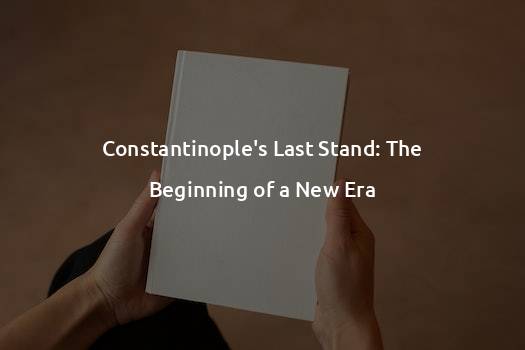Constantinople’s Last Stand: The Beginning of a New Era
Constantinople’s Last Stand: The Beginning of a New Era
In the history of humanity, certain events mark the end of one era and the beginning of another. Constantinople’s last stand is one such event that shattered the world as it had existed for centuries and paved the way for a new era to emerge. From its foundation as Byzantium to its conquest by the Ottoman Empire, Constantinople’s fall marked a pivotal moment that shaped the course of history.
The Rise of the Byzantine Empire
The tale begins in 330 AD when the Roman Emperor Constantine the Great established the city of Constantinople as the new capital of the Roman Empire. Strategically located between Europe and Asia, it became a bridge between the East and the West, thriving as a center of trade, culture, and power. This shifted the focus away from Rome and laid the foundation for the Byzantine Empire.
Under the rule of the Byzantine Empire, Constantinople became a magnificent city. Emperors adorned it with grand palaces, churches, and monuments that showcased a blend of Roman and Eastern influences. The Byzantines embraced Christianity, and the construction of the Hagia Sophia became a symbol of their devotion and architectural prowess.
A Mighty Fortress under Siege
In 1453, the Ottoman Empire, led by the ambitious Sultan Mehmed II, had its sights set on Constantinople. The city had withstood numerous sieges over the centuries, but this time, the odds were against them. Mehmed assembled a formidable army and navy, determined to cement his dominance. However, the Byzantine Emperor Constantine XI, aware of the impending danger, prepared his defenses and urged for unity among the European powers to aid in the defense of Constantinople.
The siege of Constantinople began on April 2, 1453, and lasted for 53 days. Mehmed’s forces unleashed a relentless assault, using cannons and other advanced weaponry. The Byzantines fought valiantly, but they were outnumbered and outgunned. The city walls were breached on May 29, and desperate hand-to-hand combat ensued in the streets.
The Fall and Its Consequences
Constantinople finally fell to the Ottomans on May 30, 1453, marking the end of the ancient world and the medieval era. The consequences of this event were far-reaching and transformative.
The fall of Constantinople dealt a severe blow to the Byzantine Empire, leading to its final collapse. The once-mighty empire that had endured for more than a thousand years ceased to exist, leaving behind a void that would shape the geopolitical landscape of the Mediterranean region and beyond.
The Ottoman Empire, on the other hand, rose to prominence as the new power in the region. With Constantinople as their capital, the Ottomans expanded their territories and influence, eventually becoming one of the most powerful states in the world. The conquest of Constantinople also marked the end of the Middle Ages and the beginning of the early modern period.
Moreover, the fall of Constantinople had significant cultural and intellectual repercussions. As the Ottoman Empire rose, many scholars and artists fled westward, bringing with them priceless manuscripts, knowledge, and ideas. This influx of Greek and Roman knowledge, known as the “Greek Renaissance,” played a crucial role in sparking the European Renaissance, a period of renewed interest in art, literature, science, and exploration.
The End of an Era, The Beginning of a New Chapter
The fall of Constantinople was undeniably a cataclysmic event, but it also marked the beginning of a new era. The world shifted from the medieval to the early modern period, from the dominance of the Byzantine Empire to the rise of the Ottoman Empire. It also spurred renewed intellectual and artistic vigor in Europe, leading to a transformative period of innovation and discovery.
Constantinople’s last stand serves as a stark reminder that even the mightiest empires can fall and that the tides of history are constantly shifting. Today, Istanbul stands as a vibrant metropolis filled with echoes of its history, reminding us of the enduring legacy left behind by the city that bore witness to the beginning of a new era.
TL;DR:
The fall of Constantinople in 1453 marked the end of the Byzantine Empire and the beginning of the Ottoman Empire. This event had far-reaching consequences, including the decline of the Byzantines, the rise of the Ottomans, and the cultural and intellectual influences that shaped the European Renaissance. Constantinople’s last stand symbolizes the shifting tides of history and the beginning of a new era.







